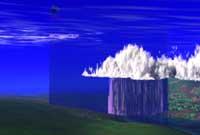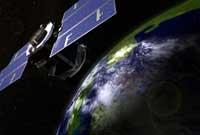Laboratory of clouds
2006/06/11 Rementeria Argote, Nagore - Elhuyar Zientziaren Komunikazioa

The preparation of a laboratory for cloud manufacturing and research has been a seven-year work. The tool they are going to use is called LACIS (Leipzip Aerosol Cloud Interaction Simulator) and is located at a Leipzip research institute in Germany. The idea is to investigate in depth the relationship between aerosols and clouds.
Influence of aerosols
Aerosols are, in general, solid and liquid particles suspended in the air. They are aerosols, for example, floating saltwater, powders and hollines emitted by volcanoes, or particles released by industry and combustion engines.
It seems that the drops of water forming the clouds are generated in aerosols. Hence the importance of studying aerosols to investigate the generation and development of clouds.

To simulate in laboratory what happens in the atmosphere, a long tube, an eight-meter vertical conduit, has been enabled. In this tube the temperature is very finely determined at different heights (between -50 and 20ºC with a precision of a hundred degrees) and humidity (with an accuracy of 0.1%). In this way, they will simulate the variations in the conditions of height in the outside environment, in the atmosphere.
To follow the development of clouds, optical spectrometers have been installed along the tube. The clouds are ultimately drops of water, and the spectrometer will measure the size and quantity of those drops.
Outside the satellite laboratory
In addition, within another cloud research project, two satellites have been launched: CloudSat and CALYPSO . These satellites will collect data on the clouds of the atmosphere. They will work together, and the data will be collected. This is about using these data to understand how clouds absorb and reflect solar radiation. Both effects have a great influence on Earth's climate and will not be alone, as they join three other satellites already in orbit: Aqua, Aura and PARASOL with satellites for Earth observation. In this way, they will form a constellation of satellites that will analyze the different agents that influence the climate of the Earth.

To analyze the terrestrial clouds just launched two satellites: CloudSat and CALYPSO . (Photo: ANDÉN)
With data collected by satellites and research carried out in the laboratory, climate models will be enriched. They will reinforce especially the part corresponding to the clouds. They knew that the clouds had a great influence, such as the heights, densities, and colors of the clouds. But so far they have not been able to put this factor into figures. By quantitative measurement of the influence of clouds can be used in climatic models (which are mathematical models) to make forecasts.
Therefore, research carried out in the coming months and years will have as objective to know with concrete data the impact of clouds on the climate.
Published in 7K.




